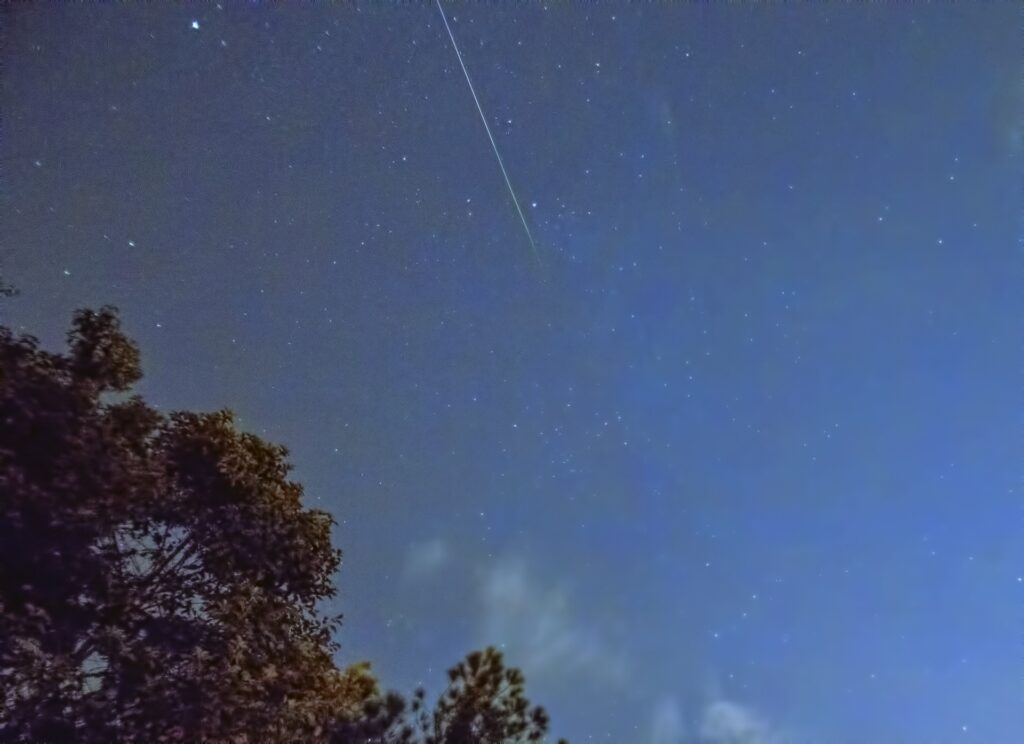Your checklist for viewing the 2020 Perseid meteor shower
August 10, 2020
By Amy Sayle
It’s time for the best meteor shower of summer—the Perseids.
The annual Perseid meteor shower has already begun and will be active well into August. The predicted peak night, when you can expect to see the most meteors, is this Tuesday evening, August 11, into early Wednesday morning, August 12, 2020.
Sometimes misleadingly called “shooting stars,” meteors are the streaks of light you see in the sky when cosmic debris slams into Earth’s atmosphere at thousands of miles an hour and vaporizes by friction. The Perseids are the result of debris left over by Comet Swift-Tuttle on its periodic trips around the Sun.
How can you best view the Perseids this year? Here’s a checklist to help you prepare:

1. Check your weather. You don’t need 100% perfectly clear skies, but you do need to avoid lots of clouds or rain. Although the peak night is Tuesday, August 11, if your weather forecast looks terrible then, you might try the night immediately before or after.
2. Choose a location. For public health reasons, Morehead can’t hold the big public skywatching event we’d originally planned, but you can still watch this on your own. Ideally, choose a dark site with an open view of the sky.
3. Choose a time. Usually, we advise those wanting to see the most meteors to pick the last dark hour before dawn, when you’re on the side of Earth that’s leading in space and sweeping up the most meteors. That would mean roughly 4 to 5 a.m. on Wednesday, August 12, 2020.
If the idea of getting up at 4 a.m. strikes you as absurd, there’s good news for you. This year, the light of the last quarter moon will interfere with pre-dawn viewing, so you might as well choose the more reasonable evening hours of Tuesday, August 11, 2020, before the Moon rises around midnight (specifically, 12:37 a.m. EDT for Chapel Hill, NC).
If you’re viewing after it first gets dark on Tuesday, don’t expect to see a whole bunch of meteors, though you might see a dramatic “earthgrazer”—a long, slow meteor. Expect to see more meteors as the evening goes on. If you’re at a very dark site, you might see on average roughly a meteor a minute. Adjust your expectations if you live in a light-polluted area; that’s probably going to be most people reading this, especially in the Triangle.
4. Get comfy. Use a blanket, sleeping bag, or reclining chair so you don’t have to crane your neck. Have an extra layer of clothing just in case the August night cools down more than you were expecting (it’s been known to happen).
5. Avoid artificial light. You don’t want non-meteor light to compete with your view of nature’s fireworks in the sky. If you’re viewing in your own yard, turn off your house lights. Consider asking your neighbors to turn off their exterior lights. If there’s an unshielded street light nearby, try to position yourself so a tree or building will block it. Avoid using white flashlights or cellphones.
6. Avoid moonlight, too. The Moon is a lovely natural source of light, but its bright light will obscure dimmer meteors in the same way that human-made light does. If you’ve chosen to watch for meteors when the Moon is up, try to position yourself so the Moon is hidden behind something. At the very least, choose a different direction of the sky to look.
7. Look toward the darkest part of your sky. You don’t need fancy equipment—just your eyes.
8. Don’t worry about knowing how to identify Perseus. The Perseids get their name from the constellation they appear to fly away from, Perseus the Hero, which lies in the northeastern sky in August evenings. But the meteors can appear anywhere in the sky.
9. Be patient. Plan on being outdoors for more than just a few minutes. Your eyes need time to adjust to the dark, and the meteors can come in clumps.
10. Look up! Yes, yes, this seems obvious. But many a prospective meteor viewer has missed out because they were looking instead at something other than the sky, such as another person, or even worse, their bright phone screen. By the time you look up in response to someone’s “oh!” exclamation, the meteor is often gone.
Also, there’s more to see in the sky than just meteors. Two planets will become visible as it gets dark. The very bright one (brighter than any star) is Jupiter; just to its left is Saturn. Stay up late enough and you’ll get to see reddish Mars after it rises in the east around 11 p.m. Stay up really late and you get to see super bright Venus after it rises around 3 a.m.
Finally, call it a success if you see even just one meteor. Actually, call it a success even if you don’t see a meteor—because you still made time to go outside, contemplate the night sky, and connect with the universe.
For more skywatching resources, check out our online hub, Morehead At Home. You can join us online—live!—every Tuesday at 10 a.m. Eastern time, for our Morehead At Home: Skywatching sessions. On Tuesday, August 11, 2020, we’ll be talking about the Perseids.
